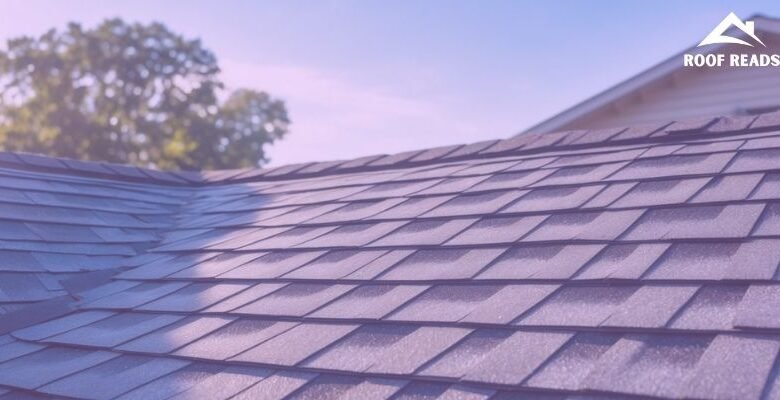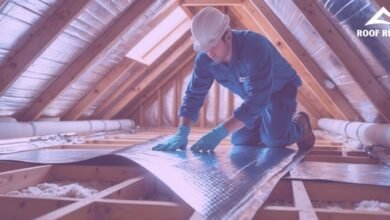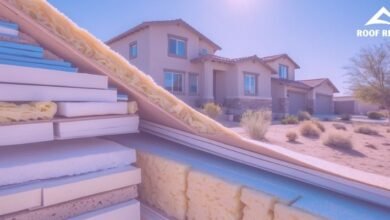How Long Do Shingle Roofs Last: A Guide to Lifespan and Durability

When you’re investing in a new roof, knowing how long it will last is crucial for planning and budgeting. Homeowners often wonder if they’ll get their money’s worth from their shingle roof. Most asphalt shingle roofs last between 20-30 years, though actual lifespan depends on the specific type of shingle, installation quality, local climate, and maintenance.
Many people are surprised to learn that “30-year shingles” don’t necessarily last 30 years. This labeling refers to the warranty period rather than the actual expected lifespan. Several factors impact durability, including sun exposure, temperature fluctuations, ventilation quality, and how well you maintain your roof.
The type of shingle makes a big difference too. Basic 3-tab shingles typically last 15-20 years, while premium architectural or dimensional shingles can last 25-30 years with proper care. Higher-end options like luxury or designer shingles might extend this timeframe even further, offering better protection and longevity for your home.
Key Takeaways
- Asphalt shingle roofs typically last 20-30 years, with premium options potentially lasting longer with proper maintenance.
- The actual lifespan of “30-year shingles” is often shorter than their warranty period due to environmental factors and installation quality.
- Regular inspections, prompt repairs, and proper attic ventilation can significantly extend a shingle roof’s functional life.
Average Lifespan of Shingle Roofs

Shingle roofs vary widely in how long they last, with lifespans ranging from 15 to over 50 years depending on the material used and environmental conditions. The quality of installation, maintenance practices, and local climate all play significant roles in determining how long your roof will protect your home.
Factors Affecting Shingle Roof Longevity
Installation Quality significantly impacts how long a roof lasts. Properly installed shingles with correct ventilation will outlast poorly installed ones by years.
Maintenance is crucial for extending roof life. Regular inspections, prompt repairs, and keeping the roof clear of debris can add years to its lifespan.
Ventilation in the attic prevents heat and moisture buildup. Poor ventilation can cause shingles to deteriorate faster from the inside out.
Material Quality varies greatly between manufacturers. Premium shingles often include enhanced UV protection and impact resistance.
Roof Pitch affects how quickly water drains. Steeper roofs typically last longer because they shed water and debris more effectively, reducing moisture damage.
Typical Lifespan Ranges by Shingle Type
3-Tab Asphalt Shingles: These budget-friendly options typically last 15-20 years. They’re the most common but have the shortest lifespan.
Architectural Asphalt Shingles: With thicker construction, these premium asphalt shingles last 20-30 years and offer better weather resistance.
Wood Shingles and Shakes: Cedar and other wood options last 20-40 years with proper maintenance but require more upkeep than asphalt.
Metal Shingles: These durable options last 40-70 years and resist severe weather conditions well.
Clay and Concrete Tiles: Highly durable with lifespans of 50+ years, these heavy options require strong roof support structures.
Slate Shingles: The longest-lasting option at 75-100+ years, slate provides exceptional durability but at a premium cost.
How Climate and Weather Conditions Impact Lifespan
Temperature Fluctuations cause expansion and contraction that can crack or warp shingles over time. Areas with extreme temperature swings see faster deterioration.
UV Exposure breaks down asphalt shingles. Southern states with intense sunlight may see 20-25% shorter lifespans compared to northern regions.
High Winds can lift and damage shingles. Coastal areas or regions prone to hurricanes need wind-rated shingles to maximize roof life.
Heavy Rain and Moisture accelerate deterioration by enabling mold and rot. Proper drainage and ventilation are essential in wet climates.
Hail and Storm Damage can significantly reduce a roof’s lifespan. Impact-resistant shingles are recommended in hail-prone areas like Colorado and the Midwest.
Types of Shingles and Their Durability

Shingle roofs vary widely in their expected lifespans depending on the materials used. Different types offer unique benefits in terms of cost, appearance, and longevity, with some lasting as little as 15 years and others potentially reaching 100 years with proper care.
Asphalt Shingles: Three-Tab vs Architectural
Three-tab asphalt shingles are the most economical option, typically lasting 15-20 years. They feature a flat, uniform appearance with cutouts that create the illusion of separate pieces.
Architectural asphalt shingles (also called dimensional shingles) offer superior durability with lifespans of 20-30 years. These premium products are thicker and have multiple layers that create a textured, dimensional look.
The quality of materials significantly affects performance. Higher-quality asphalt shingles contain more asphalt and less filler, making them more resistant to weather damage and UV deterioration.
Many modern asphalt shingles feature algae-resistant granules that prevent unsightly black streaks, particularly important in humid climates.
Wood and Wooden Shingles
Wood shingles deliver natural beauty and typically last 20-40 years when properly maintained. Cedar is the most common choice due to its natural oils that resist moisture and insects.
Wood shakes differ from shingles by being hand-split rather than sawn, creating a more rustic, textured appearance. They’re typically thicker than standard wood shingles.
These roofing materials require more maintenance than other options. Regular treatments with preservatives and fungicides can extend their lifespan considerably.
Fire resistance is a concern with wood roofing. Many manufacturers now offer pressure-treated options with fire-retardant chemicals to improve safety and meet local building codes.
Metal Shingles and Other Alternatives
Metal roofing systems can last 40-70 years with minimal maintenance. Modern metal shingles come in various styles, including some that mimic the appearance of other materials.
The exceptional durability comes from resistance to fire, insects, rot, and extreme weather conditions. Metal roofs also reflect solar heat, potentially reducing cooling costs.
Initial installation costs are higher than asphalt, but the extended lifespan offers better long-term value. Metal shingles are typically made from aluminum, steel, copper, or zinc alloys.
Many metal roofing products contain recycled materials and are fully recyclable at the end of their service life, making them an environmentally friendly option.
Premium and Specialty Shingles
Slate shingles represent the gold standard for roofing durability, often lasting 75-100+ years. These natural stone tiles are exceptionally resistant to weather and fire.
Clay tiles, common in Mediterranean and Spanish-style homes, offer similar longevity to slate. Their distinctive appearance adds architectural interest while providing excellent protection.
Concrete tiles provide an alternative to clay at a lower price point. They typically last 50+ years and can be manufactured to resemble slate, wood, or clay.
Premium shingles require specialized installation techniques and stronger structural support due to their weight. While installation costs are higher, their exceptional durability makes them cost-effective over their lifetime.
Key Factors That Influence Shingle Roof Longevity

Several critical elements determine how long your shingle roof will last, from the quality of installation to how well it handles weather extremes. Understanding these factors can help you maximize your roof’s lifespan and protect your investment.
Role of Installation and Contractor Quality
Proper installation is perhaps the most crucial factor affecting shingle roof longevity. Even the highest quality materials will fail prematurely if installed incorrectly. A qualified roofing contractor will ensure shingles are properly aligned, nailed in the right locations, and sealed correctly.
When selecting a roofing company, check their credentials, experience, and customer reviews. Professional roofing experts understand manufacturer specifications and follow them carefully. This includes using the correct number of nails per shingle and placing them in the designated nail strip.
Installation errors like improper nail placement can void warranties and lead to premature failures. Experienced roofing contractors also ensure proper overlap between shingles and correct flashing installation around chimneys, vents, and valleys.
Effects of Proper Ventilation and Insulation
Roof ventilation and insulation work together to regulate temperature and moisture levels in your attic. Without proper ventilation, heat and moisture become trapped, causing shingles to blister, crack, and age faster.
An effective ventilation system includes:
- Intake vents (usually in soffits)
- Exhaust vents (ridge vents or other roof vents)
- Proper airflow balance
Good attic insulation prevents heat transfer between your living space and attic. This reduces temperature fluctuations that stress shingles and helps maintain consistent conditions beneath your roof.
In winter, proper ventilation prevents ice dams by keeping the roof deck cool. In summer, it reduces attic temperatures that can reach 150°F without adequate airflow, which can literally bake shingles from underneath.
Impact of Weather Events and Environmental Hazards
Shingle roofs face constant exposure to elements that accelerate wear and tear. High winds can lift and crack shingles or tear them off completely. Areas prone to severe storms often experience shorter roof lifespans.
Hail damage creates weak spots in shingles where granules are knocked loose. These granules protect against UV rays, and their loss accelerates deterioration. After storms, check for granule loss in gutters—a warning sign of roof damage.
Environmental factors also play a significant role:
- Tree branches scraping against shingles cause physical damage
- Algae growth in humid climates breaks down roofing materials
- Roof slope affects water runoff (steeper roofs typically last longer)
- UV exposure in sunny climates accelerates aging
Regular inspections after weather events can identify minor issues before they become major problems requiring full roof replacement.
Signs of Aging and Extending Shingle Roof Life

Knowing what to look for can help you spot shingle problems early and take steps to extend your roof’s lifespan. Proper maintenance and timely action can add years to your shingle roof and save you money.
Recognizing Shingle Damage and Roof Leaks
Aging shingle roofs display several warning signs that homeowners should watch for. Cracked, curled, or missing shingles are clear indicators that your roof is deteriorating. These damaged areas create vulnerable spots where water can seep in and cause leaks.
Granule loss is another common sign of aging. Check your gutters and downspouts for small, gritty particles that have washed off your shingles. When shingles lose their protective granules, they become more susceptible to UV damage.
Water stains on ceilings or walls often indicate roof leaks that need immediate attention. A sagging roofline is a serious warning sign that might point to structural issues caused by water damage.
Algae growth appears as dark streaks on your roof and can accelerate shingle deterioration if left untreated.
Routine Maintenance and Regular Inspections
Regular inspections are crucial for extending shingle roof life. Schedule professional roof inspections at least once a year, especially after severe weather events.
Remove debris from your roof surface and gutters regularly. Leaves, branches, and other materials can trap moisture against your shingles and speed up deterioration.
Trim overhanging branches that touch or hover near your roof. These branches can scrape against shingles during windy conditions and drop debris that holds moisture.
Keep gutters clean and functional to ensure proper water drainage. Clogged gutters can cause water to back up under shingles and lead to roof damage.
Ensure proper attic ventilation to prevent excess heat and moisture that can warp shingles from below and shorten their lifespan.
Timely Repairs and Roof Replacement Considerations
Address repairs promptly when you spot problems. Small issues like a few damaged shingles can quickly escalate into major leaks if ignored.
When considering roof repair versus replacement, evaluate the extent of damage and the roof’s age. If your roof is approaching 20-25 years old with widespread damage, replacement might be more cost-effective than ongoing repairs.
Factor in affordability when planning for roof work. Some insurance policies may cover damage from specific events like storms, potentially reducing your out-of-pocket expenses.
Get multiple quotes from reputable contractors before making decisions about major roof work. A quality installation can significantly extend your new roof’s lifespan.
Consider upgrading to higher-quality shingles during replacement. Premium shingles may cost more initially but can offer better durability and longer life.
Frequently Asked Questions
Shingle roofs vary widely in their lifespan based on materials, installation quality, climate conditions, and maintenance practices. Understanding these factors can help homeowners make informed decisions about their roofing needs.
What factors affect the life expectancy of shingle roofs?
Several key factors determine how long a shingle roof will last. The quality of installation plays a crucial role, as poor workmanship can reduce a roof’s lifespan significantly.
The quality of materials used also matters greatly. Higher-grade shingles typically last longer than budget options.
Climate and weather exposure impact durability, with extreme temperature fluctuations, high winds, and intense UV radiation accelerating wear.
Proper ventilation in the attic helps prevent heat buildup that can damage shingles from underneath.
Regular maintenance and prompt repairs when damage occurs can extend a roof’s useful life by several years.
What is the typical lifespan of 30-year architectural shingles under normal conditions?
Despite the “30-year” label, architectural shingles typically last 20-25 years under normal conditions. This discrepancy occurs because manufacturer warranties don’t always reflect real-world performance.
In ideal conditions with proper installation and maintenance, some premium architectural shingles may reach their full 30-year potential.
Most homeowners should realistically plan for replacement after about 25 years, even with high-quality architectural shingles.
How does regional climate impact the durability of shingle roofing?
In hot, sunny climates like the Southwest, intense UV radiation can cause shingles to dry out, crack, and curl more quickly. Roofs in these regions may last 15-20% less than their rated lifespan.
Cold northern climates with freeze-thaw cycles create expansion and contraction that can damage shingles over time.
Coastal areas face challenges from salt spray and high humidity, which can promote algae growth and accelerate deterioration.
Wet climates like the Pacific Northwest may see more moss growth and moisture-related issues, potentially reducing roof life to 15-20 years without proper maintenance.
Can regular maintenance extend the life of a shingle roof, and if so, how?
Regular maintenance can add 5-10 years to a shingle roof’s lifespan. Removing debris like leaves and branches prevents moisture retention that can damage shingles.
Cleaning gutters twice yearly prevents water backup that can damage the roof edge and underlying structure.
Removing moss and algae growth helps prevent moisture retention and shingle deterioration. This is especially important in humid climates.
Scheduling professional inspections every 2-3 years helps identify and address small problems before they become major issues.
Prompt repairs after storms or when damage is noticed prevents water infiltration that can lead to more extensive problems.
What are signs that a shingle roof needs replacing?
Curling or buckling shingles indicate advanced age and weathering. This often means the roof is in the final stage of its useful life.
Missing shingles expose the roof to water damage and should be addressed immediately. Widespread missing shingles often signal replacement time.
Granules collecting in gutters or washing down downspouts indicate shingle deterioration. Heavy granule loss means shingles are losing their protective coating.
Visible sagging of the roof deck suggests structural problems that require immediate attention. This often means water damage has occurred.
Interior signs like water stains on ceilings or walls, light visible through the roof in the attic, or increased energy bills can indicate roof failure.
What are the differences in longevity between 3-tab and architectural shingles?
3-tab shingles typically last 15-20 years, making them the shortest-lived shingle option. Their thinner profile and lighter weight make them more vulnerable to wind damage and weathering.
Architectural shingles last 25-28 years on average. Their multi-layered construction provides better durability against impacts and extreme weather.
Premium or luxury shingles can last 30+ years due to their superior materials and construction. These high-end options offer the best longevity in the shingle category.
The price difference between 3-tab and architectural shingles has narrowed over time, making architectural shingles a better value considering their longer lifespan.




